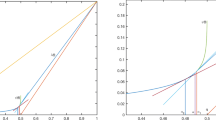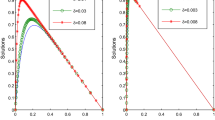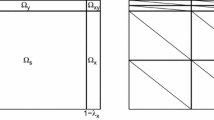Abstract
We consider streamline diffusion finite element methods applied to a singularly perturbed convection–diffusion two‐point boundary value problem whose solution has a single boundary layer. To analyse the convergence of these methods, we rewrite them as finite difference schemes. We first consider arbitrary meshes, then, in analysing the scheme on a Shishkin mesh, we consider two formulations on the fine part of the mesh: the usual streamline diffusion upwinding and the standard Galerkin method. The error estimates are given in the discrete L ∞ norm; in particular we give the first analysis that shows precisely how the error depends on the user-chosen parameter τ0 specifying the mesh. When τ0 is too small, the error becomes O(1), but for τ0 above a certain threshold value, the error is small and increases either linearly or quadratically as a function of . Numerical tests support our theoretical results.
Similar content being viewed by others
References
V.B. Andreev and I.A. Savin, On uniform with respect to a small parameter convergence of a monotone scheme of A.A. Samarskij and its modification, Comput. Math. Math. Phys. 35 (1995) 739–752 (in Russian).
A.F. Hegarty, J.J.H. Miller, E. O'Riordan and G.I. Shishkin, On numerical experiments with central difference operators on special piecewise uniform meshes for problems with boundary layers, in: Proc. of the 9th GAMM Seminar on Adaptive Methods – Algorithms, Theory and Applications, eds. W. Hackbusch and G. Wittum, Kiel (January 22–24, 1993), Notes on Numerical Fluid Dynamics, Vol. 46 (Vieweg, Braunschweig, 1994).
T.J.R. Hughes, Multiscale phenomena: Green’s functions, the Dirichlet-to-Neumann formulation, subgrid scale models, bubbles and the origins of stabilized methods, Comput. Methods Appl. Mech. Engrg. 127 (1995) 387–401.
T.J.R. Hughes and A.N. Brooks, A multidimensional upwind scheme with no crosswind diffusion, in: Finite Element Methods for Convection Dominated Flows, ed. T.J.R. Hughes, AMD Vol. 34 (ASME, New York, 1979).
V. John, J.M. Maubach and L. Tobiska, Nonconforming streamline diffusion finite element methods for convection–diffusion problems, Numer. Math. 78 (1997) 165–188.
C. Johnson and J. Saranen, Streamline diffusion methods for the incompressible Euler and Navier–Stokes equations, Math. Comp. 47 (1986) 1–18.
C. Johnson, A.H. Schatz and L.B. Wahlbin, Crosswind smear and pointwise errors in the streamline diffusion finite element methods, Math. Comp. 49 (1987) 25–38.
G. Lube and L. Tobiska, A nonconforming finite element method of streamline diffusion type for the incompressible Navier–Stokes equations, J. Comput. Math. 8 (1990) 147–158.
J.J. Miller, E. O'Riordan and G.I. Shishkin, Fitted Numerical Methods for Singular Perturbation Problems (World Scientific, Singapore, 1996).
U. Nävert, A finite element method for convection–diffusion problems, Ph.D. thesis, Chalmers University of Technology, Göteborg (1982).
K. Niijima, Pointwise error estimates for a streamline diffusion finite element scheme, Numer. Math. 56 (1990) 707–719.
R.E. O’Malley, Singular Perturbation Methods for Ordinary Differential Equations (Springer, New York, 1991).
H.G. Roos, Layer-adapted grids for singular perturbation problems, Z. Angew. Math. Mech. 78 (1998) 291–309.
H.-G. Roos, M. Stynes and L. Tobiska, Numerical Methods for Singularly Perturbed Differential Equations (Springer, Berlin/Heidelberg/New York, 1996).
M. Schäfer and S. Turek, Benchmark computations of laminar flow around a cylinder, in: Flow Simulation with High-Performance Computers II, ed. E.H. Hirschel (Vieweg, Braunschweig, 1996) pp. 547–566.
G.I. Shishkin, Difference scheme for a singularly perturbed parabolic equation with discontinuous boundary conditions, Comput. Math. Math. Phys. 28 (1988) 1679–1692 (in Russian).
M. Stynes and E. O'Riordan, Analysis of singularly perturbed two-point boundary value problems with turning points, in: Proc. Discretization Methods of Singular Problems and Flow Problems, ed. L. Tobiska, Technical University “Otto von Guericke”, Magdeburg (1989) pp. 81–88.
M. Stynes and H.-G. Roos, The midpoint upwind scheme, Appl. Numer. Math. 23 (1997) 361–374.
L. Tobiska and R. Verfürth, Analysis of a streamline diffusion finite element method for the Stokes and Navier–Stokes equations, SIAM J. Numer. Anal. 33 (1996) 107–127.
G. Zhou, How accurate is the streamline diffusion finite element method?, Math. Comp. 66 (1997) 31–44.
G. Zhou and R. Rannacher, Pointwise superconvergence of the streamline diffusion finite element method, Numer. Methods Partial Differential Equations 12 (1996) 123–145.
Rights and permissions
About this article
Cite this article
Stynes, M., Tobiska, L. A finite difference analysis of a streamline diffusion method on a Shishkin mesh. Numerical Algorithms 18, 337–360 (1998). https://doi.org/10.1023/A:1019185802623
Issue Date:
DOI: https://doi.org/10.1023/A:1019185802623




